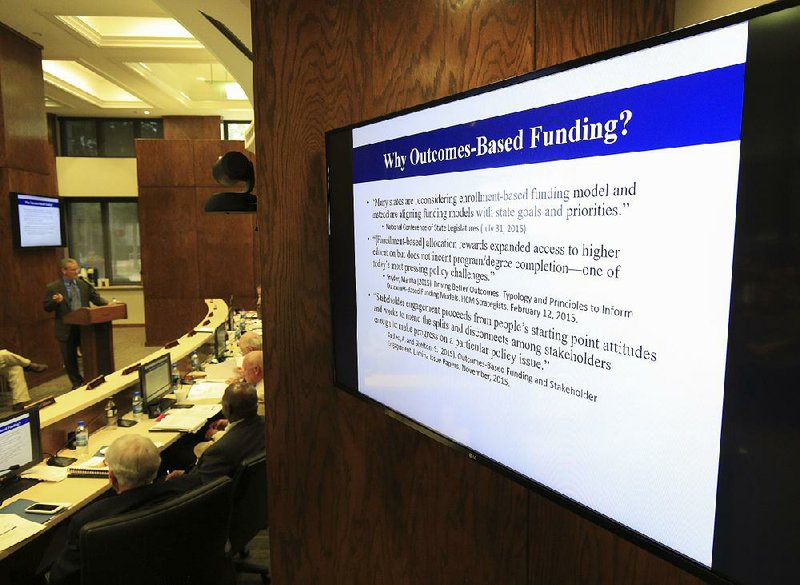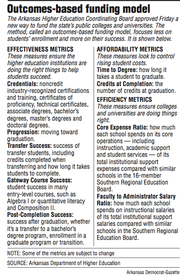The Arkansas Higher Education Coordinating Board on Friday approved a skeleton of a new method to fund the state's public colleges and universities.
Now it's in the hands of the Arkansas Department of Higher Education, which needs the approval of state House Speaker Jeremy Gillam, R-Judsonia, and Senate President Pro Tempore Jonathan Dismang, R-Searcy, to move forward.
If approved, the department staff will then begin drafting a bill to change the laws that govern funding to the institutions. Gov. Asa Hutchinson has endorsed the proposal.
"At my direction, the Arkansas Department of Higher Education began to look at potential changes to our current funding formula that would emphasize accountability, student success, and degree completion," Hutchinson said in a prepared statement.
"These changes will promote efficiency of operations, encourage on-time completion, and encourage allocation of resources to areas which directly impact student success, such as faculty salaries and academic support services. My priority continues to be increasing the percentage of Arkansans that are career-ready, equipped with degrees and industry-recognized certificates, and this new revolutionary funding model will help us achieve just that."
The goal is to enact the new funding method, called an outcomes-based funding model, in the 2017 legislative session and start using it to fund schools on July 1, 2018, said Brett Powell, outgoing director of the Arkansas Department of Higher Education.
Public colleges and universities have three main sources of income: state funding, tuition and fees, and donations. As state funding has stagnated, higher education institutions have leaned more on higher tuition and fee rates.
The new funding mechanism -- which was approved unanimously by the coordinating board -- changes the focus from enrollment to completions of certificate or degree programs. It's tied to the state's master plan for higher education, which seeks to raise the percentage of adult Arkansans who have technical certificates, associate degrees, bachelor's degrees or higher to 60 percent by 2025.
For Arkansas' 11 public universities and 22 public community colleges, the change would mean more accountability and more of an effort to have students succeed. For prospective and current students, the change could result in curbing future tuition and fee increases, some higher education leaders have said.
Under the approved framework, two- and four-year schools will be measured on several factors, ranging from credentials to the number of credits a student has when he finishes a program. Certain metrics will be weighted based on priorities, but those are still in the works. As an example, awarding a degree in science, technology, engineering or math would give a school more credit than awarding a degree in a different field.
In total, all of the schools' outcomes will generate a "productivity index," which measures progress toward goals in the state's master plan. To figure out what total funding to higher education will be, leaders will take into account the previous year's funding, that productivity measure and inflation.
To calculate each school's share, leaders will factor in the school's past year's funding, its share of the overall "productivity index" and its own outcome scores. They plan to put in a stop-gain or stop-loss measure, so no college or university can earn or lose more than 2 percent of its funding from year to year.
The new framework may have unintended consequences, such as raising admissions standards or watering down academic rigor, leaders have acknowledged. But, they also said, weighting on certain measures -- such as "student risk factors," or things like low socioeconomic status or first-generation students -- can keep part of that in check. Department staff members are also trying to figure out how to gauge what happens to a student after graduation, something that could keep academic quality up, Powell said.
As of Friday, the Higher Education Department is planning a "clean break" from the current funding methods. In that scenario, the department would use the schools' current state funding as a base and then determine either a reduction or an increase in money depending on the schools' productivity, said Tara Smith, the department's senior associate director for institutional finance.
Many of the state's higher education leaders have called the current funding method, which is based largely on enrollment, inequitable.
State funding has remained the same for colleges and universities for the past decade, Powell said. Schools that saw enrollment spikes didn't receive any more money, and those that lost enrollment didn't lose state money.
That creates a problem, in part, because policymakers never fully funded higher education to begin with. So higher education leaders have for years considered receiving 75 percent funding from the state as being "fully funded." And, at last count, 14 of the 32 schools have not reached even the 75 percent.
The enrollment-based funding method has been in place for community colleges since 2001 and for universities since 2005.
In 2011, state legislators added something new to the funding method for higher education institutions: a performance-based model, which works similarly to the new method that was approved Friday. Where the new framework has weighted measures for its scores, the performance-based method has "all or none" metrics. Where the new method rewards student success, the performance-based method penalizes schools that didn't meet the minimum score of six points out of 10.
"It's backwards to think that you can cut funds from an institution and expect them to perform better," Smith said.
The current funding models give community colleges and universities their state appropriations upfront, and if an institution falls below the minimum score, it could lose up to 10 percent of its state money.
The performance-based metrics took effect in 2013, and since then, only one school -- the University of Arkansas at Monticello -- fell below the minimum score. The rules allowed the school to submit a plan to work on its shortcomings -- mostly retaining students from year to year -- and the university improved, not losing any money.
"If you have a model, and you acknowledge that almost every single institution that contributes to the model can do better, and no one loses any money -- that's what I call the lack of performance funding," said University of Arkansas System President Donald Bobbitt. "We're 48th in the nation, and no one lost any money, any resources. I'm not trying to be too explicit here, but it kind of makes no sense to me."
The state has historically ranked in the lowest tier compared with other states in the percentage of residents with certificates or degrees. Higher education leaders are hoping the change in state funding will boost the state's educational level and, subsequently, bring more jobs to Arkansas.
Currently, there is a $400 million gap between what the present-day funding method indicates the colleges and universities should receive and what they actually receive from the state, said Powell, the Higher Education Department director. And the gap grows every year.
"So, the reality is, we don't have a funding model," he said. "What we have is a political process to try to protect what we have and hope for a small increase."
For several decades, higher education leaders have asked legislators for more funding, but it often has fallen on deaf ears, said Coordinating Board member Charles Allen of Little Rock. Policymakers often shot back that colleges and universities should not get more funding because they aren't delivering results, he said.
"I see this framework as a method to influence the governor and the Legislature to increase funding rather than just having the status quo ... and request funding and then not receive it," he said. "I support it."
Coordinating Board member Ben Pickard of Searcy said the new framework would be helpful to the state.
"I think more than that, it'll be helpful to the students," he said. "It's part of our responsibility ... to strongly recommend to the governor and to the Legislature as a board that funding be increased for higher education in this state. I know there are a lot of priorities. I come from a higher education background, and I can think of no other priority that would exceed public school and higher education."
Pickard later made a motion for the board to ask the governor and Legislature "to provide additional base funding in order to stabilize the cost of higher education for students and their families." It passed unanimously.
On Thursday and Friday, higher education leaders across the state sent out statements, showing their support for the new funding method.
Arkansas State University President Chuck Welch said he thought the framework was focused on the right things.
"I think that it is a good way for higher education to illustrate to policymakers and the public that we have no problem with being held accountable," he said. "We have no problem with being judged on the results of our work, and really, it will set us apart in that I'm not sure there's any other state agency or entity that is judged or funded based on their outcomes. And I don't think that's a bad thing."
Bobbitt, the UA System president, said higher education was aligning with other industries in funding performance.
"Let me give you an analogy," he said. "Ford Motor Company only gets paid when they sell a car, not when they start to make one."
The tricky part is in creating a funding method for higher education that has wider-varying missions.
"So if you make fenders for a car out of steel, you get ore in, and the steel ore or the iron ore is usually all about the same quality," he said. "But, you know, we take people who have perfect SAT scores and some who struggle to get out of high school because they face other challenges, and our responsibility to the state is to make sure that each of them leave our institutions capable of performing well as contributing members of society."
While leaders are supportive the funding-method change, some are also anxious because it's still "a great unknown," said Henderson State University President Glen Jones, who led the work group that helped develop the framework.
"We thought it was a great point in the process to pause and ask the board to review it," he said. "We're very preliminary at this point in terms of running the model, but we wanted to make sure that everyone understood the basic framework."
Bill Stovall, the executive director of Arkansas Community Colleges, told the board that the new funding method is "sorely needed."
"We think we have unique missions in our state, both twos and fours, and we just want to be contributing as the process moves forward to properly identify those very, very important measures," he said.
If legislators pass the framework into law in 2017, Arkansas will become the fifth state with a "very significant and robust" outcomes-based funding model, said Martha Snyder, director at Washington, D.C.,-based HCM Strategists, a higher education consulting firm. The "very significant and robust" label, she said, indicates that each state received input from stakeholders to create the new funding method, and that the new method is linked to a primary goal, such as increasing the number of degree-holders in the state.
The label also connotes that underserved students are taken into consideration, that the funding method will affect all public higher education institutions and that there's a stable source of funding, she said.
The other states with outcomes-based formulas are Tennessee, Ohio, Indiana and Colorado. Oregon has a similar funding formula, but it's only for universities and not community colleges, she said.
Arkansas would join Tennessee, which is in its sixth year of using the method, in fully basing its appropriations to colleges and universities on the metrics that are focused on student success.
Of the states that have similar funding methods, Snyder said she hadn't seen any documentation from them that their academic quality has slipped or that admissions standards have become more rigid. Cutting off access to college educations by increasing standards would be "shooting yourself in the foot," she said.
And, in fact, in a lot of cases, colleges and universities have improved academic quality, she said.
"We actually have seen institutions respond by driving very pointed, concrete and long-term conversations on campus around student success," she said.
In regard to the outcomes-based funding method, she said, "Several institutions we've worked with have used it to evaluate things they should have been evaluating anyway. ... They're enhancing quality because you're looking at barriers to student success," she said.
A Section on 07/30/2016



